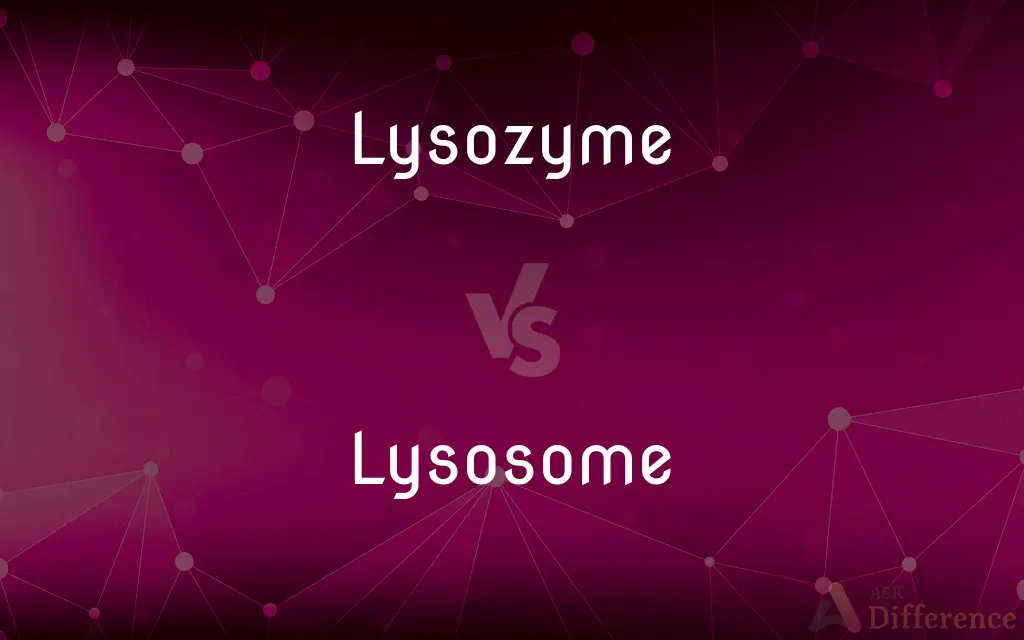Lysozyme vs. Lysosome — What's the Difference?
Edited by Tayyaba Rehman — By Fiza Rafique — Updated on September 21, 2023
Lysozyme is an enzyme found in bodily secretions like saliva, which functions to break down bacterial cell walls. Lysosome is a membrane-bound organelle in eukaryotic cells responsible for breaking down waste materials and cellular debris.

Difference Between Lysozyme and Lysosome
Table of Contents
ADVERTISEMENT
Key Differences
Lysozyme is a naturally occurring enzyme primarily found in biological fluids like saliva, tears, and mucus. It plays an essential role in the immune system by breaking down the cell walls of bacteria, thereby making it easier for the immune system to fight off infections.
Lysosome, on the other hand, is an organelle within eukaryotic cells, including human cells. These organelles are filled with enzymes that break down waste materials and cellular debris within the cell. Lysosomes are like the waste management system of a cell, helping to recycle materials.
In essence, lysozyme is a type of enzyme that functions in the degradation of bacterial cells in external secretions. It serves a critical function in initial defense against bacterial infections. Lysozymes can be found in various animals and plants, acting as a universal defense mechanism.
Contrastingly, lysosomes are intracellular structures that manage waste within a cell. They are not specific to any organism but are a general feature of eukaryotic cells. Lysosomes use a range of enzymes, not just one like lysozyme, to dismantle various kinds of biological waste.
Comparison Chart
Nature
Enzyme
Organelle
ADVERTISEMENT
Function
Breaks down bacterial cell walls
Breaks down cellular waste and debris
Location
Bodily secretions
Inside eukaryotic cells
Biological Role
Immune defense
Cellular waste management
Complexity
Singular enzyme
Contains multiple enzymes
Compare with Definitions
Lysozyme
An enzyme that breaks down bacterial cell walls.
Lysozyme in saliva helps destroy oral bacteria.
Lysosome
Part of the endomembrane system.
The lysosome works with the endoplasmic reticulum in cell maintenance.
Lysozyme
Ubiquitous in various organisms.
Lysozyme is found in both animals and plants.
Lysosome
An organelle in eukaryotic cells.
The lysosome is essential for cellular waste management.
Lysozyme
A component of the immune system.
Lysozyme is part of the body's first line of defense against infection.
Lysosome
Contains enzymes for breaking down waste.
Lysosomes contain various enzymes to degrade cellular debris.
Lysozyme
An antimicrobial agent.
Lysozyme acts as a natural antibiotic.
Lysosome
Membrane-bound cellular component.
The lysosome is encased in a lipid membrane.
Lysozyme
Found in bodily fluids like saliva and tears.
Lysozyme is abundant in tears, providing eye protection.
Lysosome
Involved in cellular recycling.
Lysosomes break down old cell parts for recycling.
Lysozyme
Lysozyme, also known as muramidase or N-acetylmuramide glycanhydrolase, is an antimicrobial enzyme produced by animals that forms part of the innate immune system. Lysozyme is a glycoside hydrolase that catalyzes the hydrolysis of 1,4-beta-linkages between N-acetylmuramic acid and N-acetyl-D-glucosamine residues in peptidoglycan, which is the major component of gram-positive bacterial cell wall.
Lysosome
A lysosome () is a membrane-bound organelle found in many animal cells. They are spherical vesicles that contain hydrolytic enzymes that can break down many kinds of biomolecules.
Lysozyme
An enzyme occurring naturally in egg white, human tears, saliva, and other body fluids, capable of destroying the cell walls of certain bacteria and thereby acting as a mild antiseptic.
Lysosome
A membrane-bound organelle in the cytoplasm of most cells containing various hydrolytic enzymes that function in intracellular digestion.
Lysozyme
(biochemistry) A bacteriolytic (or antibiotic) enzyme found in many animal secretions, and in egg white.
Lysosome
(cytology) An organelle found in all types of animal cells which contains a large range of digestive enzymes capable of splitting most biological macromolecules.
Lysozyme
An enzyme found in saliva and sweat and tears that destroys the cell walls of certain bacteria
Lysosome
An organelle found in the cytoplasm of most cells (especially in leukocytes and liver and kidney cells)
Common Curiosities
Where is lysozyme found?
Lysozyme is found in bodily secretions like saliva and tears.
How do lysozyme and lysosome differ?
Lysozyme is an enzyme, while lysosome is a cellular organelle.
What is a lysosome?
A lysosome is a membrane-bound organelle in eukaryotic cells.
What is the primary function of lysosomes?
Lysosomes break down waste materials and cellular debris.
Are lysozymes found in plants?
Yes, lysozymes are also found in some plants.
Can lysosomes repair themselves?
Lysosomes can regenerate their enzymes.
What is lysozyme?
Lysozyme is an enzyme that breaks down bacterial cell walls.
Where is the lysosome located?
Lysosomes are located within eukaryotic cells.
Are lysozymes used in food preservation?
Yes, lysozymes can be used as natural preservatives.
Is lysozyme specific to humans?
No, lysozyme is found in various animals and some plants.
What is the primary function of lysozyme?
Lysozyme functions to break down bacterial cell walls.
Do lysozymes kill viruses?
No, lysozymes are more effective against bacteria.
What types of cells contain lysosomes?
Eukaryotic cells contain lysosomes.
What happens if lysosomes malfunction?
Malfunctioning lysosomes can lead to cellular disorders.
Can lysosomes be seen under a microscope?
Yes, lysosomes are visible under an electron microscope.
Share Your Discovery

Previous Comparison
Venison vs. Veal
Next Comparison
Rogue vs. RougeAuthor Spotlight
Written by
Fiza RafiqueFiza Rafique is a skilled content writer at AskDifference.com, where she meticulously refines and enhances written pieces. Drawing from her vast editorial expertise, Fiza ensures clarity, accuracy, and precision in every article. Passionate about language, she continually seeks to elevate the quality of content for readers worldwide.
Edited by
Tayyaba RehmanTayyaba Rehman is a distinguished writer, currently serving as a primary contributor to askdifference.com. As a researcher in semantics and etymology, Tayyaba's passion for the complexity of languages and their distinctions has found a perfect home on the platform. Tayyaba delves into the intricacies of language, distinguishing between commonly confused words and phrases, thereby providing clarity for readers worldwide.














































